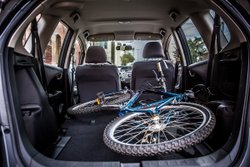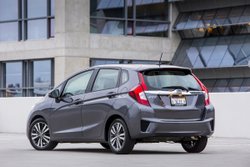An Easy Fit That Delivers Fuel Economy & Versatility
The purpose of my series, “Garage Mate for Your EV” is to help you select a companion for your electric car that meets your household’s needs. That might be an all-wheel drive vehicle, a minivan, a pickup truck or, in this case, a very versatile small hatchback.

Few cars are as aptly named as the 2016 Honda Fit. It fits the needs of most households with five-passenger seating, you can fit an outlandish amount of stuff inside the hatchback body and, for electric vehicle owners, it could be the perfect fit as a garage companion.
OK, enough play on words.
Inexpensive to buy and run, this four-door, front-wheel drive hatchback touts many positives. It has a smart, but playful appearance, a deceivingly large and versatile five-passenger interior, and enjoys top-notch Honda build quality and reliability.
The 2016 Honda Fit offers an array of model offerings that match up with different car buying budgets. The base LX with manual transmission has a sticker price of $15,890 plus $835 destination charges; a continuously variable transmission (CVT) adds $800. The EX model is priced starting at $16,690, while the EX-L, which comes with leather upholstery, has a $20,165 price tag. The EX-L with navigation at the top of lineup is priced at $21,165.
Of course, the most significant advantage to this family runabout is fuel efficiency. Thanks to its efficient four-cylinder engine, the Fit boasts an EPA number of 41-mpg highway, 33 city and 36 combined for the entry-level LX with a continuously variable transmission (CVT). EX and EX-L models with a CVT are rated at 38 highway/ 32 city/ 35 combined and the LX with manual shifter stands at 38/29/32.
Honda introduced an all-new third generation Fit for model-year 2015, and it is unchanged for 2016.
Exterior Styling

The hatchback body style is the optimum design to maximize passenger and cargo room in small cars, and the Fit is one of the more uncommonly proportioned examples. The Fit’s tall subcompact body exudes an edgy and youthful character. Its styling can almost be described as avant-garde, but some may see it as having an awkward presence.
However, the styling serves a larger purpose than mere aesthetics. Fit has a short front end highlighted by slim headlights that integrate into a solid grille design. Its steeply angled front roof pillars frame an enormous windshield. Its long, tapered roof and wagon-like body is sawed off just behind the rear wheels.
With an abundance of side-glass, small wheel openings, and an overall length of just 13.3 feet, the effect is almost toy-like. But with a tall roofline and generous-for-its-size wheelbase—the distance between front and rear axles—Fit carves out room for four adults (five in a pinch) to ride in comfort along with class-leading cargo space and versatility.
A Look Inside
Within you’ll find the expected Honda fit and finish with cabin materials on par with cars in the subcompact class. The all black interior accented with silver trim is a good design match to the exterior of the car.
The driver faces a blue backlit instrument cluster featuring a quite large center-positioned speedometer, with a tachometer residing on the left and a multi-information display on the right. A height adjustable driver’s seat combined with a tilt and telescoping steering column makes easy work of finding a comfortable driving position.
Very thin front roof pillars and a low dashboard offer superb forward visibility plus excellent front and rear sight lines. Analog controls are large, logically placed and easy to use.
Can’t say the same for the seven-inch touchscreen display in the center of the dash of our EX-L with navigation test car. It comes with the HondaLink system, which offers a variety of search, audio

and social media functions. On our EX-L, it also allowed an optional navigation app to be streamed through my iPhone in conjunction with the included HDMI port. My gripe is trying to use the touch-operated volume control and the confusing procedure for setting radio presets.
Conversely, the standard backup camera and Honda’s Lane Watch were welcome features. Lane Watch feeds a view of the passenger side blind spot to the center display when the right turn signal is engaged.
Tall folks will feel at home in the Fit’s front seats, where there’s ample head, leg and shoulder room for the six-foot-plus set. Rear doors open wide for easy entry and once seated, passengers will find more legroom than the midsize Accord—you have to sit back there to believe it.
The Base LX model is well-equipped with automatic headlights, LED brake lights, 15-inch wheels, cruise control, air conditioning and full power accessories. Bluetooth phone and audio connectivity is also standard as is a five-inch central display screen, a rearview camera and a four-speaker sound system with a CD player, an auxiliary audio jack and a USB port.
A step up to the EX adds 16-inch alloy wheels, foglights, keyless entry and ignition, a sunroof, a seven-inch touchscreen display, LaneWatch, a six-speaker audio system with an additional USB port and Siri Eyes Free. The EX-L with navigations brings leather upholstery and heated front seats.
Regardless of which model you choose, Fit’s defining feature is the innovative “Magic Seat.” This magical feature allows the interior to be configured in numerous ways, accommodating everything from tall plants to bicycles and surfboards. By moving the gas tank forward to a location under the front seats, there’s an extraordinarily deep — and useful — well between the front and rear seats.
The rear Magic Seat folds flat into the floor in a slick one-hand operation, with no need to remove the headrests—even when the front seats are all the way back. The load floor becomes perfectly flat, unlike those in many rivals, creating a mammoth 52.7 cubic feet of storage.
The seat’s design also enables the rear seat cushions to flip up, creating a side-to-side chasm behind the front seats. The front passenger seatback folds forward so Fit can carry long items such as a ladder or skis.
Driving the 2016 Honda Fit

A naturally aspirated, direct-injected 130 horsepower 1.5-liter Earth Dreams engine powers all trim level models. Like Mazda’s Skyactiv, Earth Dreams is an assemblage of fuel-efficient technologies.
Granted, 130 horses doesn’t sound like much in these days of turbocharged fours, but it was more than adequate for the task of motivating our 2,600-pound Fit EX-L.
While a little more than eight seconds for a 0 to 60 mph sprint isn’t much of an adrenaline rush, Honda’s celebrated i-VTEC variable lift-and-timing valve technology is tuned here for a broad and powerful midrange. Peak torque of 114 foot-pounds is widely available, enhancing responsiveness in a wide variety of situations.
Our Fit’s engine was mated to a CVT borrowed from the Civic, and it’s a good one. A new torque converter design and the infinitely variable ratio range gave the feeling of a quicker acceleration from a standing start than the mile-a-minute time indicates.
The CVT’s “S” mode provided seven manually-selectable ratios, which allowed controlling the power delivery on twisty backcountry roads using the steering wheel-mounted paddle shifters. The S mode is actually quite good at quickly selecting the right ratio for a corner exit, but the paddle shifter adds better control when it’s time to decelerate into a tight corner or jet out the other end.
What the Fit lacked in power, it made up in handling. The electrically assisted rack-and-pinion steering system was communicative and responsive, easily noticed on quick transitions such as lane changes and in cornering.
The Fit is equipped with a MacPherson front suspension, while the rear set up is subcompact-typical—a torsion-bar setup—which works nearly as well as an independent design in negotiating

quick corners. Brakes are disc in front, and rear drum brakes hold costs down without imposing much negative effect on stopping distance or fade-resistance.
The Fit is no Mini Cooper when it comes to handling, but it is rather agile. On sharp, switchback roads, Honda’s engineering trumps the plebeian blueprint. The car responds quickly to steering inputs and eagerly bites into corners, yielding to nose plow only on high-speed turns that reveal the limited grip of the 16-inch tires.
In-town driving was a no-muss, no-fuss affair. Power was more than adequate in suburbia, and at modest speeds the suspension tackled bumps and dips in a gracious manner. Parking, either parallel or head-in, was accomplished with ease.
On the highway, the Fit held a straight line with few steering wheel corrections to keep between the lines. Unlike driving on city streets, the Fit’s suspension becomes a little raw when speeds increase, particularly in encounters with pavement expansion joints. At higher freeway speeds the engine noise is a little raucous, but livable.
However, fuel economy is most likely a higher priority than sharp handling for the typical buyer. Like all cars—hybrid, diesel or gasoline powered—the Fit’s consumption of fuel is determined by how it’s driven. Used in the typical fashion as a grocery-getter, kid-hauler and commuter car with the ECON button engaged for best fuel economy, we averaged 38 mpg during a week-long, 223-mile test drive.
Economics

The sticker price is where most consumers will raise an eyebrow. The price for the base 2016 Fit LX of $15,890 is $1,010 more than the Ford Fiesta Hatchback and a whopping $1,660 more than the base Nissan Versa Note.
In its defense, Fit has a Prix Fixe menu—all models in the lineup have a set suite of features; factory options are unavailable. On the other hand, the Fiesta and Versa Note offer comfort and convenience features a la carte style—nearly everything except air conditioning can be extra. Standard features on all 2016 Fits are quite extensive.
On a day-to-day basis, the Fit performs its driving duties admirably. It scoots about town with little effort and when it hits the highways, has no problem keeping up with the flow. Where the Fit really shines is inside. Seating is comfortable, knobs and controls are easy to reach and operate, and that trick rear seat expands the already-generous cargo area to a space that rivals small crossover SUVs.
With its 33 city/41 highway rating for the LX model, the 2016 Honda Fit is unquestionably the top subcompact fuel miser on the road, and easily has a range of more than 300 miles on a full tank of regular gas. That’s pretty impressive for a small car that can easily fit in your garage next to your electric vehicle.
Related Stories You Might Enjoy:
Road Test: 2016 Honda Fit
Road Test: 2015 Honda Fit
Road Test: 2016 Honda HR-V
News: Honda Smart Home Integrates EV Into House
Disclosure:
Clean Fleet Report is loaned free test vehicles from automakers to evaluate, typically for a week at a time. Our road tests are based on this one-week drive of a new vehicle, which does not address issues such as long-term reliability or total cost of ownership. In addition we are often invited to manufacturer events highlighting new vehicles or technology, during which we may be offered free transportation, lodging or meals. We do our best to present our unvarnished evaluations of vehicles and news irrespective of these inducements. Our focus is on vehicles that offer the best fuel economy in their class or are among the top mpg vehicles on the market. In addition, we aim to offer reviews and news on advanced technology and the alternative fuel vehicle market. We welcome any feedback from vehicle owners and are dedicated to providing a forum for alternative viewpoints. Please let us know your views at publisher@cleanfleetreport.com.

0 thoughts on “Garage Mate for Your EV: 2016 Honda Fit”